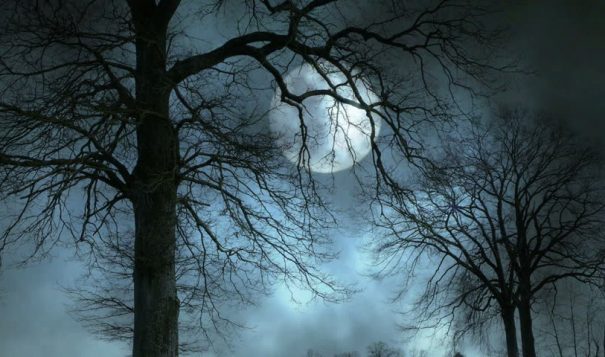
On moonlit nights on the Pine Ridge Reservation, the Holy Rosary Mission School graveyard could be seen clearly through the tall windows of our third floor dormitory. As the moonlight reflected off of the tombstones those of us sleeping near the big windows hid our heads under the covers.
One night many years ago a Jesuit priest saw something burning in the graveyard. He went to investigate and saw the image of the Devil glowing on a tombstone. He put out the fire and called Brother Eben to chisel the image of the Devil off of the tombstone. To this very day if the face of the Devil, now nearly obliterated, can still be seen and the tips of his horns are still visible. One Halloween KEVN-TV in Rapid City sent a news team to the mission school to tape the image on the tombstone for the nightly news.
There were many spooky stories that emanated from the mission boarding school, now called Red Cloud. One story I can verify was the organ that played eerie tunes and could be heard in our dormitory into the wee hours of the night.
There are former students who swore that late at night they would wake up and see a nun dressed in black, with no head, floating through the aisles between the bunk beds.
We were often awakened in the middle of the night to the sound of something rolling down the concrete steps that led to the dormitory. It’s as if a bowling ball was rolling down the steps and pausing for a short time on each step before bouncing to the next step. I heard that sound several times and to this day none of us ever figured out what it was.
In the dark of the night after all of us had finally fallen asleep we would wake up to the squeak, squeak of leather shoes pacing between the rows of our bunk beds. We would listen and pull the covers over our heads, but we knew it was a Jesuit prefect trying to walk silently between the rows of beds in the dorm to check on the students. But I’ll never forget how spooky that squeaky sound was in the dark hours of the night.
Across America there are spooky stories about Indian hospitals and Indian boarding schools. The hospital in Rapid City known as the “Sioux San,” can be a spooky place for those working the late night shift. They say they can hear people talking and babies crying. The employees swear it is true.
Stories of spirits and ghosts were common on the reservation. Every community had its own story. But the one that rings true to me because I lived in that community was a story that was born at Wounded Knee. The elders would sit on the benches in front of the Wounded Knee Trading Post on the warm summer evenings when I was a boy and talk in whispers.
My father worked at the Wounded Knee Trading Post and we lived in one of the cabins adjacent to the store. I used to listen with fear as the elders talked about that bitter, cold day in December of 1890 when the cries of frightened women and the terrifying screams of children could be heard echoing through the woods and canyons around Wounded Knee. The Massacre happened on a freezing winter day on December 29, 1890.
The haunting stories of the 300 men, women and children slaughtered that day at Wounded Knee brought fear, pain and anger to me when I was a boy. The elders who revisited the story on those summer nights left an indelible impression on my young mind. And that was probably the scariest story I ever heard because it was true. One dark night I swear I could hear the blast of the Hotchkiss guns and hear the bullets whistling and crashing in the woods. I heard a woman scream.
(Tim Giago was born, raised and educated on the Pine Ridge Reservation. He is the recipient of the H. L. Mencken Award from the Baltimore Sun, the Honor Award for Distinguished Service to Journalism by the U. of Missouri School of Journalism and the Golden Quill Award from the International Society of Weekly Newspaper Editors. He can be contacted at najournalist1@gmail.com)
